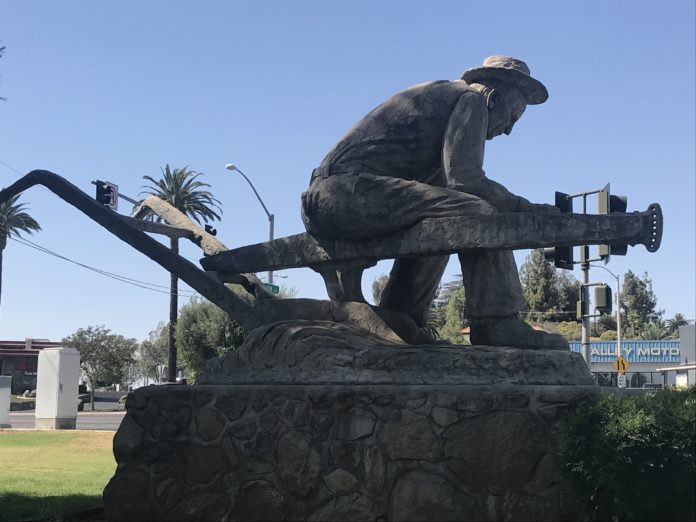 The Eastern Tule GSA board of directors met on Thursday, January 7, 2021 remotely by Zoom. Chairman Eric Borba called the meeting to order at 2pm. Under public comment attendee Phil Cooksey reported this was his first meeting and he is concerned because his property is less than one acre and he wanted to know if he can be removed from SGMA. Fair enough, attorney Aubrey Mauritson explained there will be an appeal available and most GSP provide for exemptions of small parcels.
The Eastern Tule GSA board of directors met on Thursday, January 7, 2021 remotely by Zoom. Chairman Eric Borba called the meeting to order at 2pm. Under public comment attendee Phil Cooksey reported this was his first meeting and he is concerned because his property is less than one acre and he wanted to know if he can be removed from SGMA. Fair enough, attorney Aubrey Mauritson explained there will be an appeal available and most GSP provide for exemptions of small parcels.
General Manager Rogelio Caudillo started things with an announcement of updates to the ETGSA website that will make it easier to sign up with the GSA. Then the minutes were approved with out comment.
Under administration matters the first item was electing new officers. Director John Corkins nominated the existing slate and everyone agreed. Ditto on committee chairs.
Blueprint for Recharge
Next Caudillo updated the board on the Land IQ ET data on white area lands. A document setting a formal agreement was presented and the board approved without comment. Next ETGSA was asked to participate with the San Joaquin Valley Water Blueprint study.
Dr. Scott Hamilton* of the Blueprint explained there has been some additional supplies from Delta flood flows that could help with the Valley’s aquifer recharge needs throughout the area. He said one plan is expanding the Friant Kern Canal would provide the opportunity to move water to the eastern side of the Valley right in the middle of ETGSA. The Blueprint team is looking for ways to make this happen as there are tremendous groundwater quality and recharge benefits. Stantec Engineering is performing the  investigation and doesn’t do so for free. The audio was a bot spotty through here and the figure presented on screen wasn’t legible, it was so small I couldn’t read it. I think the amount is about a quarter of a million dollars for the Tule Subbasin share of the study’s costs. Eastern Tule’s share of that is about $110,000. It’s not an insignificant amount but the board was receptive. A motion was carried to contribute to the study in two payments and to approach the white area landowners to contribute as well. Good for them.
investigation and doesn’t do so for free. The audio was a bot spotty through here and the figure presented on screen wasn’t legible, it was so small I couldn’t read it. I think the amount is about a quarter of a million dollars for the Tule Subbasin share of the study’s costs. Eastern Tule’s share of that is about $110,000. It’s not an insignificant amount but the board was receptive. A motion was carried to contribute to the study in two payments and to approach the white area landowners to contribute as well. Good for them.
Eyes in the Skies
Next Dr. Joel Kimmelshue of Land IQ made a presentation to the board saying he wants to help explain how the satellite evapotranspiration measurements work. He said there are 88 weather stations in the Southern San Joaquin Valley. For instance these stations help to calibrate the data during smokey or cloudy conditions. He said fields as small as two acres can be monitored and there is an overall 97.6 percent accuracy statewide based on ground truthing. He said the accuracy for the San Joaquin Valley is likely higher due to the number of permanent crops. Kimmelshue put up a chart showing applied water, rainfall and consumed water in 30 almond orchards.
Kimmelshue gave a good primer on precipitation, evaporation transpiration and evapotranspiration on both irrigated and non-irrigated land. He said Land IQ keeps close tabs on rainfall with its own rain gauges. (He was working off a Power Point presentation and hopefully this will be available from ETGSA. It was a good presentation but too in depth to type up here.) Kimmelshue showed how to accurately determine how much rainfall can be claimed as recharge or useable for calculating how much pumping would be allowed. There is a scenario where fallowed land would not gain any recharge from rainfall due to evaporation.
Borba said it doesn’t add up to have a zero recharge from an inch of rain on fallow land. He said the hydrogeology report from Thomas Harder’s initial study is wrong or Land IQ is wrong. I don’t think he was calling anyone a liar, rather Borba was challenging the counter intuitiveness of measurements.
Someone asked Four Creeks Engineer Dave De Groot how allocations and credits to pumping limits are based on averages or actuals. Growers are scrambling to understand how much water they can safely pump. The calculation was 1.04 a/f of safe yield for ETGSA. De Groot explained soil types and vegetation will impact the actual totals of rainfall counted to recharge.
Sean Geivet, General Manager of Porterville, Saucilito and Terra Bella IDs asked Kimmelshue if rainfall is figured into consumptive use. Kimmelshue said if it doesn’t rain all the water consumed would be from irrigation. Geivet was trying to establish Land IQ only measures consumption regardless of water source and that is relatively a constant in establishing allocations. The variables depend on water supply amounts from either precipitation, surface or groundwater sources.
Geivet and Borba and other voices I don’t recognize were in an intense conversation about how water can be accounted for. That acre foot or so of safe yield has been used as foundational for real estate transactions, business plans and loans. The Land IQ figures caused a stir but as Kimmelshue said this is new territory and as more data is acquired changes may be necessary. One of the questions raised was; would landowners’ pumping allocations be reduced because of evaporation on fallow ground? If it was fully answered at this meeting I didn’t hear it. During this part of the meeting my spider sense was tingling from the feeling there may have been green, unripe oranges mistaken for Granny Smith apples in the discussion.
Admin Reports
De Groot gave his report on accounting for the ETGSA. He said some of the questions that keep coming up from landowners have been put into a Frequently Asked Questions format for the board to review, after Mauritson reviews them. After approval that should be posted on the website. He said the first billing, the administrative overhead of $4 per a/f will go out next month. The other invoice for transitional pumping is planned to go out quarterly. The data acquisition lags about a month and once it’s in hand it takes more time to analyze so it may still be a few months out.
should be posted on the website. He said the first billing, the administrative overhead of $4 per a/f will go out next month. The other invoice for transitional pumping is planned to go out quarterly. The data acquisition lags about a month and once it’s in hand it takes more time to analyze so it may still be a few months out.
The next item was a review of the rules and regulations and it was discovered Mauritson doesn’t work around the clock. So in the interest of being decent Corkins moved to table the item until next month after council had a chance to read it. Ryan Jensen of NGO Community Water Center asked about the timeline for developing community water allocations and Mauritson said just as soon as it can be engaged it will be and Jensen will be kept in the loop. Jensen seemed happy with that response, good for him.
There were no committee reports as there were no committee meetings in December. The board also unanimously voted to pay its bills.
Caudillo updated the board on the Tule Subbasin coordination efforts and Thomas Harder’s task updates. Porterville ID, Saucelito ID and Allensworth all had projects selected for grant funding. Not to sound like a stuck record but good for them.
No Word on Friant Kern Canal Yet, Or Was There?
The meeting then went into closed session. There was only one item. The item many of us are interested in hearing about – funding to repair the Friant Kern Canal. This was worded as significant exposure to litigation with claimant being the Friant Water Authority. Borba announced if there is any reportable action from closed session Caudillo will email it out to all interested parties. And that was that.
Just after I posted this report I received an email stating, “Chairman Borba reported the ETGSA board unanimously approved a Settlement Agreement with FWA and Arvin Edison Water Storage District, contingent on the remaining parties’ final approval. Once the other parties have approved, the document will be made publicly available.” So, that was really that.
DISCLAIMER OF RESPONSIBILITY; Waterwrights.net strives to provide readers and clients with the most complete, up-to-date, and accurate information available. Nevertheless, Waterwrights.net does not serve as a guarantor of the accuracy or completeness of the information provided, and specifically disclaims any and all responsibility for information that is not accurate, up-to-date, or complete. Waterwrights.net’s clients therefore rely on the accuracy, completeness and timeliness of information from Waterwrights.net entirely at their own risk. The opinions expressed in this report are those of the author and do not represent any advertisers or third parties.
*From the small, on-screen view it appeared that Hamilton has either wounded himself and his right arm is in a sling – we certainly hope not – or his shoulder holster was showing.
ALL RIGHTS RESERVED. Copyright 2021 by WaterWrights.net/DAW
SGMA The Sustainable Groundwater Management Act of 2014 calls for the formation of Groundwater Sustainability Areas within Basins and Sub-basins to develop Groundwater Sustainability Plans.
EASTERN TULE GSA
881 W. Morton Avenue, Suite D, Porterville, CA 93257 Phone: 559/871-7660 info@easterntulegsa.com DWR# 5-022.13
Staff: Rogelio Caudillo-General Manager, Aubrey Mauritson-Attorney
Directors: Porterville Irrigation District Eric Borba-Chairman, Saucelito Irrigation District Steven Kisling-Vice Chairman, City of Porterville-Monte Reyes, Tea Pot Dome ID-Matthew Leider, Tulare County-Dennis Townsend, Kern Tulare Water District-Curt Homes, Vandalia Water District-Dyson Schneider, Terra Bella ID- Geoffrey Galloway & White Area-John Corkins






























